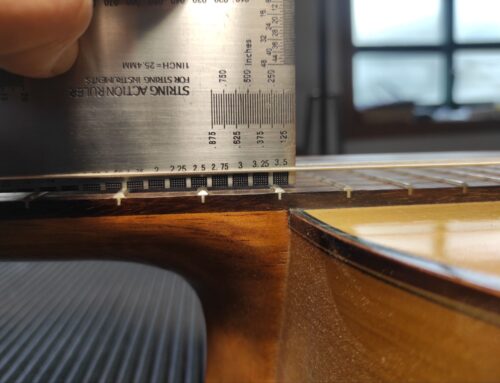You have just bought a French polished guitar. That means that you have probably spent a lot of money on it, because this type of varnish is common in high-end guitars. Logically, you may wonder what care should be taken.
You have to assume that shellac (the varnish itself used for French polishing) is very sensitive and will wear out no matter what you do. Having said that, the best thing to do is to play the guitar a lot without getting too obsessed with what I’m about to tell you. So here are some tips on how to keep your guitar’s finish in top condition.
First tip: avoid scratching the varnish with your nails.
Shellac varnish scratches extremely easily. Don’t try it, but just by rubbing the varnish with a fingernail you will have scratched your guitar. In another post we explained the benefits of French polish finish for the sound compared to other varnishes, but here we see the bad side of this finish.
So, the first advice I would give you is to avoid touching it or rubbing the guitar with your fingernails. It is also important to be careful with all kinds of objects that can scratch the varnish, such as bracelets, pendants, etc. As you may know, nail marks when playing are difficult to avoid, especially when playing some styles. That’s why, if your playing exposes the varnish to scratches, you should ideally install a plastic pickguard. In my opinion, it is best to use a removable one, to make things easier for the luthier when the varnish needs to be maintained.
Second tip: clean your guitar with a cloth after each use.
This second tip is quite obvious. Keeping the guitar clean minimizes the impact on the varnish of the corrosive agents present in the sweat. It is obvious that when we play the guitar we leave marks on it from our fingers, as well as with our forearm and so on.
This dirt may contain agents that cause the varnish to deteriorate more quickly. So using a microfiber cloth after each use will keep all those corrosive agents away from the varnish. You simply wipe it all over the guitar, including the neck as well. Here is a link to some you can find on Amazon.
Using a sleeve to play the guitar
In general, it is recommended that you avoid skin contact with the guitar with the forearm of the side you play with -the right one, if you are right-handed; the other one, if you are left-handed-. That part that is in permanent contact with the soundboard lends itself to sweat and dirt accumulating, wearing out the varnish faster. Shellac is not only sensitive to scratches, but also to heat.
So a good idea is to play with a long sleeve, or buy a specific sleeve, like this one you can find on Amazon at a quite reasonable price.
How to clean a guitar that is very dirty?
Imagine that you have been careless in the periodic cleaning of the instrument and suddenly you see that the guitar is very dirty and that the instrument has marks that just with a cloth you can’t remove. These things happen. The only thing I would say is that you should never apply any furniture cleaning product on it. Although you could do it without any problem on a guitar varnished with polyurethane, in the case of French polish, this would be terrible.
The reason is that this type of cleaning products contain abrasive agents with which you are most likely simply removing the varnish from the guitar. Yes, the stains will disappear, but you will also be removing the varnish. Shellac is a varnish that is dissolved in alcohol, so simply avoid any product that dissolves alcohol. Neither acetone. No solvents, in short.
What you should do if the guitar is very dirty is to slightly dampen a soft cloth in water and try to clean the dirt. That’s it. If it doesn’t come off with water, leave it alone. Maybe the varnish is already worn out and what it needs is a revision by the luthier. I will explain it below.
Sending periodically a French polished guitar to the luthier
The great guitar mass production industry has mislead us into thinking that the varnish does not need maintenance. This does not apply at all to shellac varnished guitars. It is a varnish from the pre-industrial era, when it seems that culturally we were more prepared to assume that things had to be periodically maintained to last for many years. Now perhaps we are accustomed to the fact that when things stop working they go into the trash can.
A guitar varnished with shellac should periodically pass through the hands of the luthier so that he can apply new coats of varnish to it.
Having said this, it is clear that a guitar varnished with French polish should periodically pass through the hands of the luthier to apply new coats of shellac. The instrument will be practically like new again, except for deep scratches that cannot be covered. How often should you send it for re-varnishing? There are no fixed rules for this, but an instrument that needs to be re-varnished will have dull areas, especially on the top and forearm area, in addition to normal wear marks.
I hope these tips have been useful to take care of your shellac varnished guitar. You can ask me any question in the comments or send me directly an email. If you want more information about the benefits of shellac over other traditional finishes on classical guitars, here is a link to a post where I talk in detail about it.






Leave A Comment